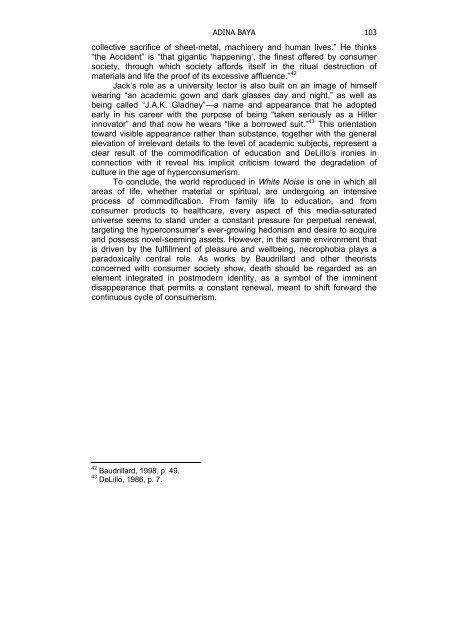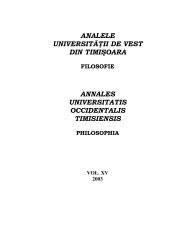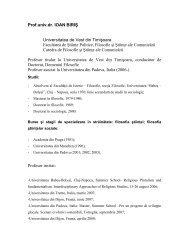VOL. IV (XXI) 2009 - Departamentul de Filosofie si Stiinte ale ...
VOL. IV (XXI) 2009 - Departamentul de Filosofie si Stiinte ale ...
VOL. IV (XXI) 2009 - Departamentul de Filosofie si Stiinte ale ...
Create successful ePaper yourself
Turn your PDF publications into a flip-book with our unique Google optimized e-Paper software.
ADINA BAYA 103<br />
collective sacrifice of sheet-metal, machinery and human lives.” He thinks<br />
“the Acci<strong>de</strong>nt” is “that gigantic ‘happening’, the finest offered by consumer<br />
society, through which society affords itself in the ritual <strong>de</strong>struction of<br />
materials and life the proof of its exces<strong>si</strong>ve affluence.” 42<br />
Jack’s role as a univer<strong>si</strong>ty lector is also built on an image of himself<br />
wearing “an aca<strong>de</strong>mic gown and dark glasses day and night,” as well as<br />
being called “J.A.K. Gladney”—a name and appearance that he adopted<br />
early in his career with the purpose of being “taken seriously as a Hitler<br />
innovator” and that now he wears “like a borrowed suit.” 43 This orientation<br />
toward vi<strong>si</strong>ble appearance rather than substance, together with the general<br />
elevation of irrelevant <strong>de</strong>tails to the level of aca<strong>de</strong>mic subjects, represent a<br />
clear result of the commodification of education and DeLillo’s ironies in<br />
connection with it reveal his implicit criticism toward the <strong>de</strong>gradation of<br />
culture in the age of hyperconsumerism.<br />
To conclu<strong>de</strong>, the world reproduced in White Noise is one in which all<br />
areas of life, whether material or spiritual, are un<strong>de</strong>rgoing an inten<strong>si</strong>ve<br />
process of commodification. From family life to education, and from<br />
consumer products to healthcare, every aspect of this media-saturated<br />
universe seems to stand un<strong>de</strong>r a constant pressure for perpetual renewal,<br />
targeting the hyperconsumer’s ever-growing hedonism and <strong>de</strong><strong>si</strong>re to acquire<br />
and possess novel-seeming assets. However, in the same environment that<br />
is driven by the fulfillment of pleasure and wellbeing, necrophobia plays a<br />
paradoxically central role. As works by Baudrillard and other theorists<br />
concerned with consumer society show, <strong>de</strong>ath should be regar<strong>de</strong>d as an<br />
element integrated in postmo<strong>de</strong>rn i<strong>de</strong>ntity, as a symbol of the imminent<br />
disappearance that permits a constant renewal, meant to shift forward the<br />
continuous cycle of consumerism.<br />
42 Baudrillard, 1998, p. 49.<br />
43 DeLillo, 1986, p. 7.




